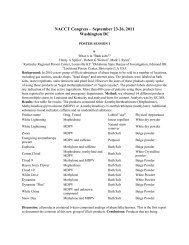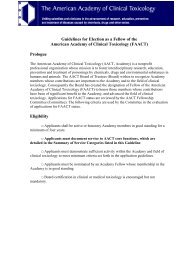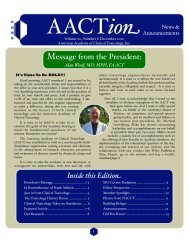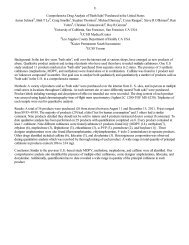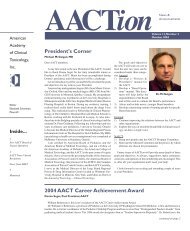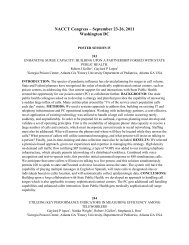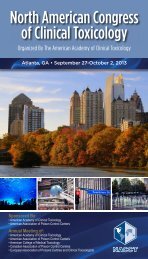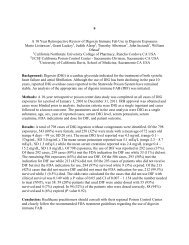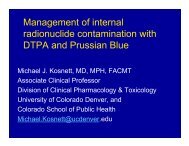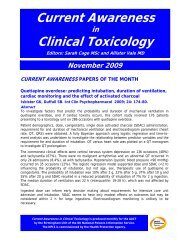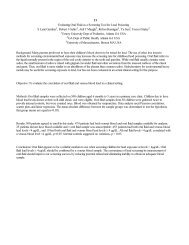Position Paper: Single-Dose Activated Charcoal - eapcct
Position Paper: Single-Dose Activated Charcoal - eapcct
Position Paper: Single-Dose Activated Charcoal - eapcct
Create successful ePaper yourself
Turn your PDF publications into a flip-book with our unique Google optimized e-Paper software.
78<br />
POSITION PAPER: SINGLE-DOSE ACTIVATED CHARCOAL<br />
obliterative bronchiolitis (100). The study demonstrated that<br />
progressive airway injury could occur from charcoal and<br />
produce obliterative bronchiolitis-like lesions.<br />
A 30-year-old male had a depressed level of consciousness<br />
following an amitriptyline overdose (98). <strong>Activated</strong> charcoal<br />
was instilled through the nasogastric tube which was in the<br />
right mainstem bronchus resulting in a decrease in oxygen<br />
saturation, wheezing, and subsequent ARDS. Bronchoscopic<br />
suctioning of the lungs returned copious amounts of charcoal.<br />
He was extubated after nine days.<br />
A 51-year-old male had activated charcoal administered<br />
inadvertently into his right lung and pleural cavity following a<br />
salicylate overdose. The patient survived both the salicylate<br />
overdose and the therapeutic insult from activated charcoal.<br />
<strong>Charcoal</strong>-colored fluid drained from a thoracostomy tube for<br />
eight weeks. He was discharged and died four days later after<br />
another untreated salicylate overdose. The autopsy revealed<br />
the presence of a charcoal-laden sterile empyema in his right<br />
hemithorax and the microscopic presence of black material in<br />
his lung parenchyma. Death was consistent with salicylate<br />
poisoning (the post-mortem salicylate concentration was said<br />
to be 2600 mg/L) and there was no evidence that charcoal<br />
contributed directly to his demise (101).<br />
An inebriated and incarcerated 37-year-old female was<br />
administered activated charcoal in the pre-hospital setting. The<br />
nasogastric tube had been placed in the right mainstem<br />
bronchus and penetrated the pleura resulting in the<br />
development of pneumothorax. Approximately 500 mL of<br />
activated charcoal was drained via a thoracostomy tube. The<br />
patient recovered without complications (102).<br />
After multiple attempts, a 19-year-old female was lavaged<br />
following an ibuprofen overdose. <strong>Activated</strong> charcoal was<br />
administered via the lavage tube and shortly thereafter she<br />
experienced respiratory difficulty. An X-ray showed a widened<br />
mediastinum, pneumopericardium and subcutaneous emphysema<br />
that was consistent with esophageal perforation. Mediastinal<br />
inflammation developed and was thought to be due to<br />
the presence of both gastric contents and the charcoal-sorbitol<br />
mixture. The patient was discharged after 14 days (103).<br />
A 19-month-old male ingested an unknown quantity of<br />
European elderberries and activated charcoal 13 g was<br />
administered via a gastric tube. The child became cyanotic<br />
immediately following inadvertent bronchial administration of<br />
the charcoal. Respiratory failure resolved after tracheal<br />
aspiration of the charcoal. The child was discharged 12 days<br />
later and at four months, no neurological or respiratory<br />
complications were present (104).<br />
A 4-year, 11-month-old asthmatic female was given<br />
activated charcoal via a nasogastric tube after ingesting an<br />
unknown pill. The nasogastric tube was placed inadvertently<br />
into the trachea necessitating intubation and mechanical<br />
ventilation for five days. The child developed a chronic longterm<br />
inflammatory response that was deemed through biopsies<br />
to be independent of her pre-existing asthma conditions (105).<br />
From case reports, Arnold et al. (106) associated pulmonary<br />
edema as a consequence of activated charcoal aspiration and<br />
conducted an animal study to determine if the presence of<br />
charcoal affected the pulmonary microvasculature and was<br />
responsible for the development of pulmonary edema. <strong>Charcoal</strong><br />
was introduced into harvested, perfused rat lungs and into the<br />
lungs of living animals. The investigation demonstrated that the<br />
charcoal produced an increase in lung microvascular permeability.<br />
However, the authors also concluded that a number of<br />
other factors may have contributed to the problem as well.<br />
Following an ingestion of tetracycline, a 20-year-old male<br />
received pre-hospital care that included placement of a<br />
nasogastric tube (99). The patient vomited and pulled out<br />
the tube. The tube was replaced and activated charcoal was<br />
administered. Sorbitol was administered subsequently in the<br />
emergency department and the patient was released. The next<br />
day he returned in respiratory distress and required intubation.<br />
Endotracheal aspiration revealed charcoal-laden mucous. He<br />
recovered uneventfully.<br />
Pulmonary aspiration associated with inadequate airway<br />
management and following lavage in an obtunded patient<br />
should not be considered a complication or an adverse effect<br />
of charcoal, as charcoal does not cause the aspiration. When<br />
aspiration does occur following the administration of charcoal,<br />
it is difficult to attribute subsequent pulmonary problems to<br />
the charcoal as opposed to the gastric contents. Aqueous activated<br />
charcoal in the gastric aspirate probably does not increase<br />
the complication rate of aspiration, though the inclusion<br />
of povidone increases pulmonary complications (3). Fungal<br />
contamination of activated charcoal (107) may complicate<br />
pulmonary aspiration, but this problem of contamination is<br />
rare and isolated. The complications following aspiration of<br />
activated charcoal per se are consistent with those following<br />
the aspiration of gastric contents.<br />
Corneal Abrasions<br />
Two combative patients had charcoal spilled on their eyes<br />
during administration and developed transient corneal abrasions<br />
that resolved without complications (6).<br />
Intubation/Endoscopy Difficulty<br />
While not an adverse reaction associated with activated<br />
charcoal, charcoal discoloration of upper airway impeded<br />
visual intubation of a patient who was being treated for a<br />
tricyclic antidepressant overdose (108).<br />
A 75-year-old female with a past medical history that<br />
included the use of activated charcoal to treat a tricyclic<br />
antidepressant overdose was found to have aggregates of<br />
activated charcoal in her distal esophagus and stomach during<br />
endoscopy for an unrelated medical problem. It was thought<br />
that the charcoal became entrapped in mucosal tears that<br />
occurred as a consequence of traumatic intubation. There were<br />
no sequelae that could be attributed to the presence of the<br />
activated charcoal (109).



